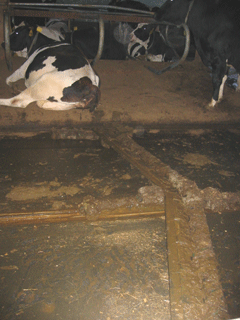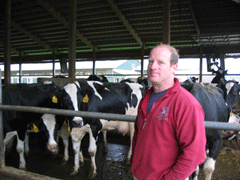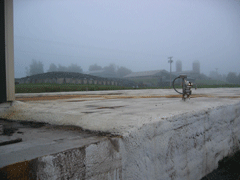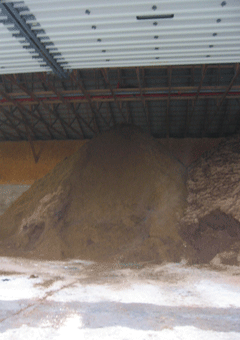Manure Magic
Air Date: Week of July 4, 2008

A machine scrapes the poop out from under the cows and it is piped to the digester for processing. (Photo: Ashley Ahearn)
Dealing with large amounts of manure on industrial livestock farms has never been easy, environmentally sustainable, or profitable, but that's starting to change. Living on Earth's Ashley Ahearn reports on a growing industry that capitalizes on the power of cow and pig poop.
Transcript
GELLERMAN: Livestock on U.S. farms produce enough manure every year to fill a convoy of trucks stretching from San Francisco to Washington, D.C. Sure it smells, but there are bigger problems: water pollution and all the methane gas this waste releases. Methane from farms is a major contributor to global warming. But a growing number of farmers are helping to solve the problem and in the process, they’re turning their animals’ manure into money.
Living on Earth’s Ashley Ahearn reports.
[LOUD COW MOOING]
AHEARN: At five o’clock on a cold Vermont morning, even the cows don’t seem too happy to be awake.
[LOUD COW MOOING]
AHEARN: Blue Spruce Dairy Farm in Bridport, Vermont, is home to 2,000 of these vocal ladies. They’re huddled together in long pens, mooing, munching hay.
[COW PEEING CLOSE BY]
AHEARN: And going to the bathroom - to the tune of 35,000 gallons of pee and manure a day. Dealing with the waste of his large herd of Holsteins used to be a heavy burden for Earl Audet, who co-owns Blue Spruce farm with his two brothers, but things have changed.

A machine scrapes the poop out from under the cows and it is piped to the digester for processing. (Photo: Ashley Ahearn)
AHEARN: In 2005 Earl and his brothers installed an Anaerobic Digester to collect the manure and wastewater from his dairy barns and turn it into energy - enough energy to meet all the farms needs, and power 400 Vermont homes to boot.
Walking down the long concrete aisles of one of the barns, Audet points out where the alchemy of transforming poop to power begins.
AUDET: We’ve got these alley scrapers right here that run back and forth 24 hours a day. They’re always scraping the floor, scraping the manure up, and it dumps it in the center of the barn.

Earl Audet, co-owner of Blue Spruce Farm in Bridport, Vermont. (Photo: Ashley Ahearn)
AUDET: Yup. They just kinda step over it pretty naturally. You get some that aren’t real smart about it for a while. They’ll kinda freak out and run around.
AHEARN: From here, the manure and wastewater is pumped up the hill to another noisier building, a barn-turned-power-plant.
[LOUD DIGESTER MACHINE NOISE]
AUDET: So this over here is your digester itself. A concrete box, with a concrete cover. You’re standing on top of 12 feet of manure and the top two feet is where the gases rise and you capture the gases off from the top.
AHEARN: Inside this big concrete box, bacteria is eating cow manure and wastewater, and giving off methane gas, which is then burned on site in a generator to make electricity. Blue Spruce Farm used to pay 8,000 dollars a month for electricity, but that bill has disappeared. Now the power company is paying them 2,000 dollars a month for the extra power they feed back into the grid.

The concrete digester holds 21 days worth of manure and collects the methane gas that accumulates as manure decomposes inside. (Photo: Ashley Ahearn)
AUDET: This here is the separated manure, that’s cow manure that’s been through the digester.
AHEARN: The other byproduct of the bacteria is a fine, feathery brown substance that can be used as bedding for the cows instead of traditional wood shavings.
AUDET: It’s a lighter fluffier product and it doesn’t have those wood chips that can act like slivers. I mean, if we were laying on slivers we wouldn’t like it.
AHEARN: It’s 7,500 dollars per month in bedding Earl Audet doesn’t have to buy anymore. The digester is making it possible to look beyond the next milk check.
But for Audet it’s not just about the money. Authorities have been cracking down on manure run off.
AUDET: Oh yeah. it’s all about the environmental part of it all. To begin with it’s the land management, the nutrient management, that is making it something that we have to look into as a large farm, to keep Lake Champlain cleaner, to keep the waterways cleaner.

After remaining moisture is squeezed out, processed manure is re-used as bedding, saving Blue Spruce farm thousands of dollars each month. (Photo: Ashley Ahearn)
AHEARN: When nitrogen and phosphorous-rich manure is left in ponds or spread over fields, rain carries the nutrients to nearby water bodies, like Lake Champlain, creating dead zones where there’s not enough oxygen for marine life to survive.
There are now more than 140 dead zones worldwide, most of them the result of agricultural runoff.
That’s all in addition to livestock air emissions of ammonia and methane. Each year, manure from U.S. livestock is responsible for about two million metric tons of methane.
ROOS: And that’s about 7% of the total anthropogenic methane emissions from the United States.
AHEARN: Kurt Roos is head of the U.S. Environmental Protection Agency’s Agstar program, which encourages sustainable practices with grants to green-thinking farmers, including Earl Audet. Roos says that as the industry grows, digesters are taking a bite out of the methane emissions from livestock waste.
ROOS: I’ve been doing this a long time and we’ve seen enormous growth. When I first started this there were only like, ten systems running. It’s reduced about 70,000 metric tons already.
AHEARN: The number of anaerobic digesters has more than doubled in the last two years. Around the country, about 120 digesters produce enough electricity for 25 thousand homes.
Harnessing cow methane is a growing industry with a lot of potential, and it’s attracting a new kind of business, call them methane middlemen, cow poop capitalists: people who don’t farm – instead they buy up the rights to farmer’s manure and sell the energy.
MORALES: We will do all the engineering work, you know, scout out the location, we’ll have all the documentation in place and negotiate to sell the energy, whether that’s with the local gas or electric utility or some other end user.
AHEARN: Albert Morales is the Executive Vice President of The Environmental Power Corporation, a 60 million dollar, publicly traded company.
MORALES: Right now we’re focusing on larger scale facilities. In Texas we are developing a large-scale facility that will process the manure from about 10,000 cows.
MIDKIFF: I would question whether that’s even a farm or not.
AHEARN: Ken Midkiff is the Sierra Club Conservation Chair for Missouri.
MIDKIFF: My guess is that the animals, the cows in this case, Holsteins probably, are kept on concrete where the manure and the feces and the urine are easily collected. Chances are those are going into an anaerobic. Is that a farm? I mean, you know, Sounds like a factory to me. It sounds like an industrial process.
AHEARN: The Sierra Club opposes anything that might encourage what some call factory farms, even though the digesters lower methane emissions, and dead zone causing run-off.
A recent study by the EPA says 7,000 more farms in the U.S. could install digesters. And if they did it would reduce methane emissions by 60 percent and supply power for 630,000 more homes. Not the solution to the whole energy picture perhaps, but a big part of the cow pie.
For Living on Earth, I’m Ashley Ahearn in Bridport, Vermont.
Links
U.S. EPA’s Agstar, Agriculture Renewable Energy program
Anaerobic Digester Report by the National Renewable Energies Lab
Living on Earth wants to hear from you!
Living on Earth
62 Calef Highway, Suite 212
Lee, NH 03861
Telephone: 617-287-4121
E-mail: comments@loe.org
Newsletter [Click here]
Donate to Living on Earth!
Living on Earth is an independent media program and relies entirely on contributions from listeners and institutions supporting public service. Please donate now to preserve an independent environmental voice.
NewsletterLiving on Earth offers a weekly delivery of the show's rundown to your mailbox. Sign up for our newsletter today!
 Sailors For The Sea: Be the change you want to sea.
Sailors For The Sea: Be the change you want to sea.
 The Grantham Foundation for the Protection of the Environment: Committed to protecting and improving the health of the global environment.
The Grantham Foundation for the Protection of the Environment: Committed to protecting and improving the health of the global environment.
 Contribute to Living on Earth and receive, as our gift to you, an archival print of one of Mark Seth Lender's extraordinary wildlife photographs. Follow the link to see Mark's current collection of photographs.
Contribute to Living on Earth and receive, as our gift to you, an archival print of one of Mark Seth Lender's extraordinary wildlife photographs. Follow the link to see Mark's current collection of photographs.
 Buy a signed copy of Mark Seth Lender's book Smeagull the Seagull & support Living on Earth
Buy a signed copy of Mark Seth Lender's book Smeagull the Seagull & support Living on Earth

